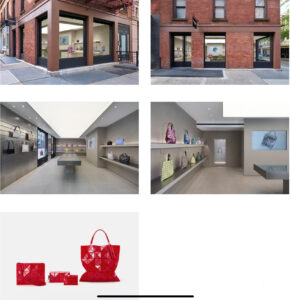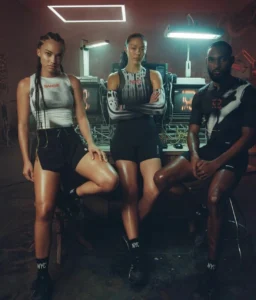On the sun-washed corner of Prince and Wooster Streets in New York’s SoHo—a district long known for nurturing artful rebellion and architectural nuance—something extraordinary has unfolded. Not an installation, not merely a storefront, but a sculptural experience. After decades of quiet reverence in design-savvy circles and a cult following across Asia, BAO BAO ISSEY MIYAKE has opened its very first U.S. flagship store: a 513-square-foot architectural gem that is as fluid, geometric, and transformative as the bags that bear the brand’s name.
This is not a retail space—it is a kinetic shrine to a design philosophy that redefined what a bag could be. It is, above all, an ode to structure as emotion, shape as freedom, and form as experience.
A New Geometry in American Retail
BAO BAO ISSEY MIYAKE’s arrival in New York is more than commercial—it is symbolic. For years, the brand has existed on the fringes of American consciousness, known to those who sought it out: architects, dancers, museum-goers, and avant-garde enthusiasts who understood the power of polyhedral abstraction. Until now, the only way to encounter the label firsthand in the U.S. was via tightly curated corners of department stores. With the opening of 126 Prince Street, the brand is making its first architectural declaration to America—and it’s one of softness, clarity, and deeply considered modularity.
The store’s interior was conceived by Moment, a Tokyo-based design studio whose practice draws deeply from Japanese spatial philosophy. The key reference point? The “irori”, a traditional Japanese sunken hearth. Noted for being a warm communal hub in rural households, the irori represents connection through structure. Here, that domestic intimacy has been reinterpreted through a ceiling-mounted light fixture, which glows like a suspended halo over the center of the room, encouraging flow and gathering—not just of bodies, but of ideas.
Materiality and Minimalism: The Architecture of Reduction
Everything inside the SoHo flagship is guided by one principle: reduction reveals complexity.
- The walls, plaster-finished in a chalky, almost ceramic matte, are intentionally quiet—absorbing light rather than reflecting it, grounding rather than showcasing.
- At the center stands a custom hammered aluminum table, its texture echoing the brand’s iconic triangular tessellations. It is not a retail fixture; it is a plinth of utility.
- Mirrors subtly encase select corners—not for vanity but for dimensionality. They extend space the same way the BAO BAO bags extend from flatness to sculpture.
Together, these elements create not a boutique but a sensory stage. The entire store feels alive—ready to fold, pivot, or expand at a moment’s notice, much like the bags themselves.
The Language of Triangles: Innovation That Moves
At the heart of BAO BAO ISSEY MIYAKE’s DNA is the triangle—not as ornament but as architecture. Each bag is composed of geometric panels arranged on mesh fabric, allowing the object to flex and reshape with the wearer’s movements. What begins as a two-dimensional grid becomes a dynamic form—adaptable, personal, and alive.
This philosophy of form-following-freedom was born from ISSEY MIYAKE’s long-standing interest in technology, movement, and the human body. The bags are, in essence, kinetic sculptures—they react to motion, weight, and light. They are also wholly democratic: devoid of gender, devoid of season, and unfixed in size.
This architectural thinking about softness has made BAO BAO bags popular not just with fashionistas, but with industrial designers, engineers, and conceptual artists. They are everyday origami—shapes that listen to how you live.
“Lucent Love”: A Heartfold to the City
To commemorate the opening of its SoHo flagship, BAO BAO ISSEY MIYAKE has released an exclusive capsule collection: “Lucent Love.” Composed entirely of monochromatic red variations of their signature bags, the line is a love letter—literal and figurative—to New York City.
- The collection includes totes, crossbody bags, and modular pouches, all rendered in a high-gloss cherry red finish.
- The promotional visuals depict the Lucent bag folded into a perfect red heart—not as kitsch, but as an act of sincere visual poetry. The heart is not stitched but shaped, not printed but folded.
- Available only at the 126 Prince Street store, the collection’s exclusivity is deliberate. It transforms a product into a moment, a limited offering as fleeting and precious as a first kiss in a new neighborhood.
This capsule is not just about color. It’s about gesture. In a city that thrives on pace, BAO BAO has made an offering of pause.
BAO BAO’s Design Ethos: Between Future and Function
ISSEY MIYAKE was never a brand to obey the rules of Western fashion seasons or hierarchical traditions. From the beginning, its founder emphasized technology as an extension of nature, and fabric as a terrain to explore.
With BAO BAO, this ideology has found a new frontier. Originally launched as a subdivision under the ISSEY MIYAKE label, BAO BAO began with the aim of developing functional accessories with engineered unpredictability—bags that could take on new forms with each movement. The goal wasn’t to dazzle, but to interact. To breathe.
In this, BAO BAO aligns closely with modern computational design, where software and algorithmic patterning inspire physical product. The triangle grid system can be compared to digital voxel modeling, except here it’s rendered in tactile reality: soft, glossy, and touch-responsive.
As wearable architecture, BAO BAO occupies a rare space: at once sculptural and functional, conceptual and accessible. The bags do not dictate a way of dressing—they adapt to you.
The SoHo Flagship’s Cultural Implication
SoHo is not just a shopping district—it is an aesthetic argument. For BAO BAO to choose this intersection of fashion, design, and street-level intimacy as its American home is not accidental. It is a way of declaring:
“We are here. But we are not here to conform.”
In a world saturated by trend cycles and logomania, BAO BAO offers a geometry of calm. Its placement on Prince Street, alongside architectural firms, contemporary galleries, and other Japanese tastemakers (from Muji to Rei Kawakubo’s Dover Street Market lineage), feels less like retail expansion and more like urban choreography.
The store invites slow discovery. There is no pressure to buy—only to notice. To pick up a bag and turn it in your hand. To see how it collapses, glides, and reforms like urban fabric.
Beyond Bags: A Philosophy of Movement
If ISSEY MIYAKE’s Pleats Please line explored movement in cloth, BAO BAO explores movement in form. The SoHo flagship allows customers to interact not only with a product but with an idea: that things should not be fixed, that our possessions should respond to us, not resist us.
Each BAO BAO piece is a kind of portable light sculpture. The gleam of its glossy triangles changes depending on angle, sun, and shadow. They photograph like glass, feel like rubber, and fold like paper. Yet they are durable, washable, and weightless.
In this way, BAO BAO achieves something profound: beauty without fragility, art without preciousness.
The Future Folded
What does the future hold for BAO BAO ISSEY MIYAKE in the U.S.? If the SoHo flagship is any indication, it will be less about saturation and more about strategic resonance. This isn’t a brand looking to flood the market. It is a brand content with occupying space that matters—space that reflects its values of patience, curiosity, and engineering empathy.
Expect slow rollouts. Pop-ups that echo installations. Collaborations not with influencers, but with designers, choreographers, perhaps even roboticists.
After all, BAO BAO was never about trend. It was always about transformation.
No comments yet.








